2. 中国科学院大学, 北京 100049;
3. 中国科学院地球科学研究院, 北京 100029;
4. 中国科学院地质与地球物理研究所, 岩石圈演化国家重点实验室, 北京 100029
2. University of Chinese Academy of Sciences, Beijing 100049, China;
3. Institutions of Earth Science, Chinese Academy of Sciences, Beijing 100029, China;
4. State Key Laboratory of Lithospheric Evolution, Institute of Geology and Geophysics, Chinese Academy of Sciences, Beijing 100029, China
自板块构造理论提出以来,板块俯冲起始的动力学机制一直是科学界研究的热点,且通常认为板块俯冲开始于洋内俯冲(Stern, 2004; Stern et al., 2012)。到目前为止,初始俯冲的原因和机制仍然没有很好的解释;同时由于现今构造格局中典型洋内俯冲环境的产出并不广泛,使得洋内俯冲起始和演化过程的研究也存有较大争议。代表古大洋残片的蛇绿岩是板块间缝合线存在、恢复洋陆格局及构造演化的重要岩石学标志,记录了大洋岩石圈的形成演化信息,其属性、就位过程及构造内涵对研究洋内俯冲的起始和演化及相应的资源效应都具有重要意义(Gass, 1968; Coleman and Keith, 1971; Dewey and Bird, 1971; Coleman, 1977; 吴福元等, 2014)。因此,蛇绿岩也被认为是研究俯冲初始过程最好的地质材料(van Hinsbergen et al., 2015)。特提斯构造带(图 1)是现今最大的碰撞造山带,保存了古老和现今大洋俯冲、陆-陆碰撞造山等威尔逊旋回的完整地质记录,是公认的研究板块构造理论(如板块俯冲起始过程)最为理想的天然实验室。而其中广泛出露的蛇绿岩岩石组合和构造特征,更是记录了新特提斯洋的演化信息,是研究新特提斯洋俯冲起始过程的关键。
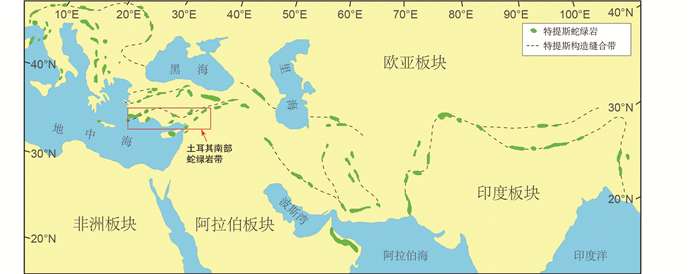
|
图 1 特提斯蛇绿岩分布图(据Dilek and Furnes, 2009修改) Fig. 1 Distribution of Tethyan ophiolites (modified after Dilek and Furnes, 2009) |
目前,关于初始俯冲的形成机制存在多种假说,主要包括:1)由大洋板块或者被动边缘的裂隙转变而来(McKenzie, 1977; Dickinson and Seely, 1979; Mitchell, 1984; Mueller and Phillips, 1991);2)已经存在的俯冲发生极性倒转(Mitchell, 1984);3)转换断层到海沟的转变(Uyeda and Ben-Avraham, 1972; Hilde et al., 1977; Karson and Dewey, 1978; Casey and Dewey, 1984);4)大陆或者岛弧边缘顶部沉积加载所致(Dewey, 1969; Fyfe and Leonardos, 1977; Cloetingh et al., 1982; Karig, 1982; Erickson, 1993; Toth and Gurnis, 1998; Pascal and Cloetingh, 2009);5)板块作用力使得断层汇聚于大洋板块边缘的断裂处(Mueller and Phillips, 1991; Toth and Gurnis, 1998; Doin and Henry, 2001; Hall et al., 2003);6)板块年龄差使得大洋板块断裂区域存在横向的热浮力差而触发俯冲(Gerya et al., 2008; Nikolaeva et al., 2008; Zhu et al., 2009);7)断裂作用使得岩石圈中存在拉张解耦(Kemp and Stevenson, 1996);8)岩石圈横向组分浮力差导致Rayleigh-Taylor不稳定性(Niu et al., 2003);9)岩石圈中存在较多被释放的游离水(Regenauer-Lieb et al., 2001; Van Der Lee et al., 2008);10)上浮大陆或岛弧地壳对大洋板块形成自发的逆冲作用(Mart et al., 2005; Goren et al., 2008; Nikolaeva et al., 2010);11)岩石圈地幔中存在小尺度对流(Solomatov, 2004);12)热化学地幔柱和岩石圈之间的相互作用(Ueda et al., 2008);13)陨石撞击使得地幔的热流值重置(O'Neill et al., 2017)。根据驱动力来源的不同,上述假说可分为诱发和自发两类(Gurnis et al., 2004; Stern, 2004)。诱发模型的特点是俯冲板块的初始化无法通过板块自身的性质差异产生,而由外界应力诱发;更多的可能是一种基于上升的地幔柱与岩石圈发生相互作用而引起的地球动力学过程,典型实例如Mussau海沟。而自发模型的触发机制则存在两种观点:1)板块相互运动及其间的相互作用力所致;2)年龄差诱发而成,典型实例如Izu-Bonin-Mariana和Tonga-Kermadec的汇聚边界(彭鸿和冷伟, 2017)。大部分SSZ型蛇绿岩的岩石序列与Izu-Bonin-Mariana洋内弧俯冲系统具有良好的对应关系(Pearce and Robinson, 2010; Whattam and Stern, 2011; Zhang et al., 2016),所以自发俯冲模型可能更符合洋内初始俯冲机制。不论哪种假说,初始俯冲过程中均会留有某些地质印迹。因此,寻找更多的地质观测记录,并对其开展系统的研究工作将有助于进一步理解和制约初始俯冲的机制和时限。对于自发产生的板块俯冲初始化过程,从洋内洋底扩张的证据,到初始俯冲的大面积岛弧活动和玻安岩的出露以及地壳的快速生长(Stern and Bloomer, 1992)均存在于Izu-Bonin-Mariana洋内弧俯冲系统,使其吸引了众多学者的目光,并开展了广泛的研究和讨论。根据Metcalf and Shervais (2008)和Stern (2004)等的认识,可将洋内初始俯冲系统的形成过程主要分为以下3个阶段(图 2):

|
图 2 洋内初始俯冲作用形成演化模式图(据Stern, 2004; Metcalf and Shervais, 2008; Stern et al., 2012改编) Fig. 2 Formation and evolution model of the intra-oceanic initial subduction (modified after Stern, 2004; Metcalf and Shervais, 2008; Stern et al., 2012) |
1) 软流圈上涌阶段:两个具有不同年龄、厚度、密度和温度的大洋板块之间存在一个薄弱带(转换断层或构造带)。大洋板块沿转换断层或构造带发生断裂错位之后,年龄相对较老的低温高密度大洋板块因重力失稳而下沉,板块破裂沉降为软流圈上涌提供了空间(图 2a)。而上涌的软流圈发生减压熔融作用触发了具有似洋中脊玄武岩的最早期岩浆活动(Reagan et al., 2010; 肖庆辉等, 2016; 彭鸿和冷伟, 2017)。
2) 壳源物质直接加入阶段:随着板块的下沉,其上覆的壳源物质(海洋沉积物、蚀变洋壳等)不同程度地直接加入到地幔源区,与软流圈地幔橄榄岩相互混合,有些可能来不及熔融就直接被裹入到上涌的软流圈岩浆中,产生具有似洋中脊玄武岩-岛弧拉斑玄武岩的过渡型成分变化的岩浆作用(图 2b)。
3) 地幔楔熔融阶段:随着板块俯冲的进行,俯冲倾角开始发生变化,并伴随着俯冲板块的脱水作用。地幔楔橄榄岩在软流圈上涌和俯冲板片脱水产生流体的共同作用下再次发生部分熔融,形成高镁安山岩、玻安岩等火山岩(图 2c)。此外,冷板块的俯冲可使上部板块温度降低,同时使得上部板块底部的橄榄岩发生变质交代作用,而俯冲物质熔融产生的熔体也可进一步交代其上覆岩石。
因此,在大洋板块初始俯冲过程中,从软流圈的上涌到俯冲板块洋壳脱水与熔融析出的流体组分作用于上部地幔楔(Reagan et al., 2010; 肖庆辉等, 2016),地幔橄榄岩不断发生部分熔融的同时,上部的镁铁质岩石序列也从类似洋中脊型的弧前玄武岩到过渡类型玄武岩系列以及玻安质系列,分别对应于洋内初始俯冲的不同阶段。弧前玄武岩与玻安岩均是在俯冲初始阶段的伸展环境下形成的,但相对而言,与玻安质相关的岩浆事件要晚于弧前玄武岩,玻安岩也因而被认为是弧前环境的重要岩石学标志。上述一系列岩浆活动的过程也正是俯冲型(SSZ)蛇绿岩的形成过程。蛇绿岩就位过程中热的超镁铁质岩与下伏岩石接触,使得下伏岩石发生高温变质,形成变质底板(Spray and Williams, 1980; Dilek, 2003; Wakabayashi and Dilek, 2003)。通常认为,变质底板形成于新生俯冲带的开启阶段,稍晚于蛇绿岩的就位启动时间(<2Myr)(Wakabayashi and Dilek, 2003),因此变质底板的变质年龄可精确限定蛇绿岩就位的启动时间。综上所述,地球化学成分多样的镁铁质岩石、玻安岩、SSZ型蛇绿岩以及变质底板分别从不同方面记录了洋内初始俯冲过程。
2 初始俯冲的地质记录 2.1 镁铁质岩石地球化学成分的多样性通过对Izu-Bonin-Mariana洋内弧中镁铁质岩石地球化学变化特征的总结归纳,发现镁铁质岩石存在由底部拉斑质向上部钙碱性过渡的趋势,且早期弧前玄武岩显示似洋中脊玄武岩的特征,而后期的钙碱性岩石显示俯冲物质的加入,分别对应于早期拉张背景和后期俯冲作用的改造(Ishizuka et al., 2011)。由于后期俯冲作用可以交代改造早期形成的镁铁质岩石,导致岛弧体系内原生镁铁质岩石的成分发生不同程度的改变(Pearce, 2014),若初始俯冲不同阶段形成的镁铁质岩石以岩脉的形式侵入到蛇绿岩中,则保存相对完好。因此,蛇绿岩中的基性岩脉可用于限定其形成的构造环境和源区特征(Dilek and Furnes, 2014; Pearce, 2014)。通过对不同期次基性岩脉的研究,可以了解不同阶段所处的构造背景,进而反演大洋形成-俯冲的演化过程。已有的研究表明,蛇绿岩及其变质底板基性岩石的原岩成分差异显著,可隶属于不同构造环境的碱性或拉斑玄武质岩浆,如洋中脊玄武岩、岛弧拉斑玄武岩和洋岛玄武岩(Parlak et al., 1995; Çelik et al., 2006; Parlak, 2006; Lian et al., 2017)。同时,一个引人注意的现象是,世界很多地方的蛇绿岩各单元以及变质底板中普遍发育侵入的基性岩脉(主要为辉绿岩或辉长岩),且地球化学成分变化明显(Juteau et al., 1977; Dilek et al., 1999; Çelik and Chiaradia, 2008; Elitok and Drüppel, 2008; Dilek and Thy, 2009; Lian et al., 2017)。不论这些基性岩浆事件与其所侵入的蛇绿岩和变质底板在成因上是否存在联系,它们都可能记录了大洋初始俯冲阶段构造环境的演变。因此,对蛇绿岩中镁铁质岩石开展系统工作,可以查明蛇绿岩形成时的构造背景和岩浆活动,为进一步研究初始俯冲提供关键信息。但是,目前的研究仅集中于这些基性岩脉的地球化学特征,而忽略了对应的野外产状和年代学分析,严重制约了人们对俯冲事件起始及后续地质过程的认识和理解。
2.2 SSZ型蛇绿岩蛇绿岩的就位过程与板块运动密切相关,标志着区域尺度甚至全球尺度下的地球动力学体系调整(Robertson, 2002; Dilek and Furnes, 2011)。蛇绿岩最初被认为是形成于大洋中脊(MOR)扩张中心的典型洋壳,后来新增加的大量蛇绿岩和洋盆研究数据表明板片俯冲才是蛇绿岩形成过程的重要阶段,并将这种由板片俯冲而形成的蛇绿岩命名为俯冲带(SSZ)型蛇绿岩(Pearce et al., 1984; Stern, 2004)。根据对全球范围内蛇绿岩的现有研究,学术界普遍认为,洋中脊形成的蛇绿岩(MOR-型)极少存在(<0.001%)(Coleman, 1977; Pearce, 2003),而绝大部分都是与俯冲作用密切相关的SSZ型蛇绿岩(Pearce, 2003),并且只有10%的蛇绿岩具有完整的岩石组合序列(van Hinsbergen et al., 2015)。大洋岩石圈通常由于板块汇聚作用而残留于缝合带内,当板块发生仰冲时,在缝合带中残留的大洋岩石圈即为MOR-型蛇绿岩,其年龄代表着主洋盆内一次裂解事件的发生时间;当板块发生向下俯冲时,俯冲岩石圈(包括洋中脊玄武岩和亏损的地幔橄榄岩)和地幔楔发生部分熔融形成岩浆弧(史仁灯, 2005),对应于SSZ型蛇绿岩,其年龄代表的是主洋盆开始俯冲消减并在俯冲带上产生新洋壳的时间。通常认为,洋内俯冲作用是形成SSZ型蛇绿岩的主要机制(史仁灯, 2005),最典型例子如Izu-Bonin-Mariana弧前,巴布亚新几内亚的Cape Vogel以及Tonga弧前。研究表明,Bonin和Mariana弧前地区的初始弧火成岩组合剖面基本一致,底部均为似洋中脊型玄武岩,基底则是SSZ型蛇绿岩,自下而上依次为地幔橄榄岩、辉长岩、席状岩墙(Reagan et al., 2010; Ishizuka et al., 2011)。这一对应关系进一步表明SSZ型蛇绿岩形成于初始俯冲阶段的弧前背景(Stern, 2004; Reagan et al., 2010; Ishizuka et al., 2011; Whattam and Stern, 2011; Stern et al., 2012)。因此,明确蛇绿岩的属性、就位过程及其构造内涵对初始俯冲的研究显得至关重要。目前学者对于蛇绿岩的研究仅集中于序列中的某一层位,而忽略了对整体框架的考虑,导致不同学者对同一蛇绿岩的构造背景存在不同的观点。其次,前人对蛇绿岩的研究主要关注于蛇绿岩的岩石地球化学特征及构造背景的鉴别,尚未对蛇绿岩的就位机制及时限开展全面研究和讨论。毫无疑问,上述不足均严重制约了人们对蛇绿岩属性的明确以及俯冲起始过程的认识。
2.3 变质底板变质底板通常被认为是与蛇绿岩构造侵位有关的热动力学变质作用产物。蛇绿岩在就位过程中,位于上盘的仍处于高温状态的超镁铁质岩体沿断层逆冲至下伏岩石之上,这一过程可以导致断层之下的镁铁质岩石及沉积岩发生高温变质作用,从而形成上部斜长角闪岩、麻粒岩及下部绿片岩的倒转变质梯度(Spray and Williams, 1980; Dilek, 2003; Wakabayashi and Dilek, 2003),这一变质岩席即被称为变质底板。变质底板的厚度可达500m,主要位于蛇绿岩地幔部分的底部,也可包裹于地幔橄榄岩内(如Dewey and Casey, 2013; van Hinsbergen et al., 2015)。变质底板不仅是蛇绿岩构造就位过程的热效应产物,同时也是形成新洋壳的一种机制,与蛇绿岩的演化有着密切关系。通常认为变质底板形成于俯冲初始的早期阶段(Hacker, 1990),并且已有的年代学研究显示地球上大多数变质底板岩石的冷却年龄与相关蛇绿岩的地壳岩石的结晶年龄接近(Guilmette et al., 2008, 2009, 2012; Plunder et al., 2016),表明这些蛇绿岩在形成后不久便发生了构造就位。因此,变质底板的出现是蛇绿岩形成并就位于初始俯冲阶段的关键证据,也被认为是SSZ型蛇绿岩的重要标志(Coleman, 1977; Wakabayashi and Dilek, 2000, 2003; Bortolotti et al., 2013)。但到目前为止,关于变质底板形成的根本机制仍存在疑问,针对其温压条件和构造特征的工作也相对匮乏(Spray, 1984; Wakabayashi and Dilek, 2003; Dewey and Casey, 2013);变质底板的岩石组合在蛇绿岩中的构造属性亦尚不明确,例如:变质底板与蛇绿岩相接合并折返到地表的方式和过程仍不明确,变质底板的温压条件和蛇绿岩的厚度不相匹配等问题。
2.4 玻安岩与铬铁矿成矿作用根据对横穿现代岛弧剖面的地球化学变化特征的研究和总结,通常认为从岛弧向海沟方向,由于熔体产生的深度逐渐变浅使得地幔橄榄岩变得更加难熔,从而造成靠近海沟的弧岩浆比远离海沟的弧岩浆更加亏损。其中横剖面上的火山岩成分存在由底部拉斑质弧前玄武岩向上部玻安质岩石过渡的趋势(Ishizuka et al., 2011)。由于上述两组岩石之间并无显著的不整合现象,因而是目前提出的蛇绿岩形成于俯冲初始阶段和弧前环境的重要证据(Stern et al., 2012),玻安岩也因此被认为是在俯冲初始阶段具有异常高热流值的地幔楔部分熔融的产物(Stern et al., 2012),是弧前盆地形成环境的重要岩石学标志(Crawford et al., 1989)。同时,玻安岩与拉斑玄武岩存在成因上的继承和渐变关系,故而蛇绿岩中岩性变化特征也可被用来判断大洋的俯冲方向。
玻安岩不仅具有构造环境的指示意义,还与蛇绿岩中豆荚状铬铁矿的成矿作用密切相关。很多研究学者认为在俯冲背景下地幔楔的方辉橄榄岩与富H2O的玻安质熔体在浅部地幔发生橄榄岩-熔体反应从而形成豆荚状铬铁矿(Roberts, 1988; Zhou et al., 1996, 2005; Melcher et al., 1997; Rollinson, 2005; Uysal et al., 2007; 熊发挥等, 2014; 章奇志等, 2017; 刘霞等, 2018)。根据现有研究,铬铁矿可被划分为高Cr型(Cr#=100×Cr/(Cr+Al)>70)、高Al型(Cr#<50)和高Cr-高Al过渡型(50<Cr#<70)(Dick and Bullen, 1984; 鲍佩声等, 1999; 兰朝利等, 2006; Zhou et al., 2014; Uysal et al., 2018)。已有的对比结果表明,蛇绿岩中高Cr和高Al型铬铁矿在成分上分别与玻安岩和洋中脊玄武岩中的铬铁矿具有可比性,进而推断高Cr型铬铁矿与玻安质熔体有关(图 2c),高Al型铬铁矿则与洋中脊玄武质熔体有关(图 2a)(如Arai, 1992; Arai and Yurimoto, 1994; Zhou et al., 1994, 1996, 1998; Arai and Miura, 2016)。然而,豆荚状铬铁矿的成因一直颇有争议。东太平洋扩张洋脊中高Cr铬铁矿的发现(Allan and Dick, 1996; Arai and Matsukage, 1996; Dick and Natland, 1996)表明高Cr铬铁矿不一定来自俯冲带环境。另外,由于铬铁矿中超高压异常矿物的发现(Yang et al., 2007, 2014; 杨经绥等, 2008; Trumbull et al., 2009; Yamamoto et al., 2009; Robinson et al., 2015; Xu et al., 2015),学者们进一步提出铬铁矿的形成环境可能位于地幔过渡带(410~660km)(杨经绥等, 2007, 2008)。事实上前人的工作主要通过铬铁矿的主微量元素和铂族元素及铬铁矿中的矿物包裹体来研究铬铁矿的成矿作用,对其母岩浆的制约也主要是建立在铬铁矿成分对比之上,而忽略了同样重要的主要矿物—橄榄石的成分对比(Xiao et al., 2016; 苏本勋等, 2018)。
3 新特提斯洋俯冲起始在土耳其南部的地质记录 3.1 土耳其南部蛇绿岩和变质底板分布东地中海广泛出露蛇绿岩,从塞尔维亚经阿尔巴尼亚、希腊再到土耳其、叙利亚(图 1)。这些蛇绿岩通常被认为是来自欧亚大陆和冈瓦纳大陆之间的洋盆,属于新特提斯洋岩石圈的残余(Şengör and Yılmaz, 1981; Robertson and Dixon, 1984; Dilek and Moores, 1990),其中多数已成为研究新特提斯洋演化的绝佳对象和经典实例。同时,这些蛇绿岩下部普遍发育一套角闪岩相变质岩石组合,如前南斯拉夫的Dinaride蛇绿岩(Lanphere et al., 1975)、阿尔巴尼亚蛇绿岩(Beccaluva et al., 1994; Vergely et al., 1998; Dimo-Lahitte et al., 2001)、土耳其境内的İzmir-Ankara-Erzincan(Önen and Hall, 2000; Önen, 2003)和Tauride带(Lytwyn and Casey, 1995; Dilek and Whitney, 1997; Çelik et al., 2006; Parlak, 2006)、叙利亚的Baër-Bassit蛇绿岩(Al-Riyami et al., 2002)以及阿曼的Semail蛇绿岩(Searle and Malpas, 1980, 1982; Hacker, 1990; Searle and Cox, 1999)。
土耳其作为特提斯造山带的重要组成部分,其境内分布有大量的侏罗纪和白垩纪的蛇绿岩或蛇绿混杂岩(图 3)(Dilek and Moores, 1990; Dilek et al., 1999; Karaoğlan et al., 2013a),自北向南分可划分为两个蛇绿岩带:北部带和南部带,其中北部蛇绿岩带被认为是新特提斯洋分支Pontide洋的残余,而南部带则属于新特提斯主大洋的岩石圈残片(Dilek and Moores, 1990)。南部带上产出的大部分蛇绿岩均保存有较为完整的蛇绿岩单元序列,自下而上依次包括底部地幔方辉橄榄岩和镁铁-超镁铁质堆晶岩以及上部席状岩墙群、枕状熔岩和玻安岩(Parlak and Delaloye, 1999; Robertson, 2002; Dilek and Furnes, 2009; Chen et al., 2015, 2018; Lian et al., 2017)。这些蛇绿岩蚀变较弱,并赋存有丰富的铬铁矿床。同时,土耳其南部带中的蛇绿岩种类繁多,包括MOR型、SSZ型和MOR-SSZ过渡型(Bağcı and Parlak, 2009; Dilek and Thy, 2009; Lian et al., 2017; Sayit et al., 2017; Su et al., 2018),指示了构造环境的多样性,从而为特提斯洋从扩张到俯冲的完整演化过程的细致研究提供了理想场所。另外,土耳其南部蛇绿岩带在保存有完整的蛇绿岩序列的同时,还伴随着变质底板的出露(Juteau, 1980; Dilek and Moores, 1990)。蛇绿岩及变质底板下伏蛇绿混杂岩主要由蛇绿岩相关组分、斜长角闪岩块体、火山岩、硅质岩和灰岩组成,年龄分布于二叠纪到晚白垩世。
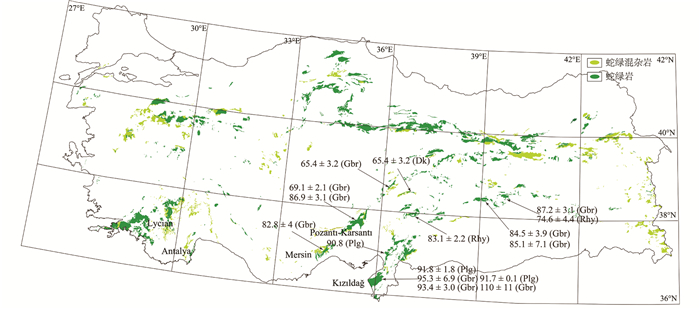
|
图 3 土耳其南部蛇绿岩中的基性岩的年龄(据土耳其矿物研究与勘探总局,2002①改编) 年龄数据引自Dilek and Thy, 2009; Karaoğlan et al., 2012, 2013a, b; Parlak et al., 2013. Plg-斜长花岗岩;Gbr-辉长岩;Rhy-流纹岩;Dk-辉绿岩岩脉 Fig. 3 Ages of mafic rocks in ophiolites, southern Turkey (modified after General Directorate of Mineral Research and Exploration, Turkey, 2002) Age data from Dilek and Thy, 2009; Karaoğlan et al., 2012, 2013a, b; Parlak et al., 2013. Plg-plagiogranite; Gbr-gabbro; Rhy-rhyolite; Dk-dolerite dyke |
① 土耳其矿物研究与勘探总局.2002.地质勘查报告
3.2 蛇绿岩中的基性岩脉土耳其南部蛇绿岩带内各岩石单元及变质底板中普遍发育基性侵入岩脉(Dilek and Thy, 2009; Lian et al., 2017),并具有一系列显著特征:1)从岩性来看,这些基性岩脉以辉绿岩-辉长岩为主;2)基性岩脉大量侵入到橄榄岩当中,部分情况下甚至侵入于玄武岩中;3)侵入同一蛇绿岩中的基性岩脉并不一定是同期形成的。如Pozantı-Karsantı蛇绿岩的地幔方辉橄榄岩中侵入的基性岩脉产状多变,根据野外观察可初步将基性岩脉分为三期:一期颗粒较粗(>0.5mm),脉体宽度较小(<0.5m);另外两期脉体,岩石粒度细,且侵入方向截然不同(图 4a, b),其中一期被颗粒较大的基性岩脉穿插,另一期则未见此现象。Kızıldağ蛇绿岩的方辉橄榄岩中零星分布有基性侵入岩脉,相应产状也明显不同:淡色基性岩脉发生扭折变形,其侵入时间可能早于蛇绿岩的构造就位(图 4c);而暗色基性岩墙则较为平直,无明显扭折变形,可能与蛇绿岩同期形成(图 4d),并且部分基性岩脉中还可见橄榄岩捕掳体;4)通过收集土耳其南部蛇绿岩中基性岩脉的地球化学特征资料,发现其地球化学成分变化很大,从似洋中脊玄武岩、岛弧拉斑玄武质到玻安质的成分均有所体现(图 5a, b);5)已有的报道显示这些基性岩脉的形成时代跨度较大,年龄范围为62~121Ma(图 3)。综上所述,土耳其南部蛇绿岩带中发育的基性岩脉应为多期次岩浆事件的产物,既可能源自大洋扩张阶段地幔熔融产生的熔体在上升过程中与橄榄岩反应,也有可能是蛇绿岩侵位到地壳浅部层位后,其下部地幔发生部分熔融而新形成的侵入体(吴福元等, 2014)。其中,后者的地幔熔融既可能代表另外一次洋壳扩张事件(Girardeau et al., 2002),也可能是与蛇绿岩无关的一次地幔岩浆事件的产物(Juteau et al., 1977)。不论这些基性岩浆事件与它所侵入的蛇绿岩及变质底板在是否存在成因联系,该基性岩脉均可能记录了土耳其南部蛇绿岩“形成-演化-侵位-侵位后”过程中岩浆活动和构造环境的变化。
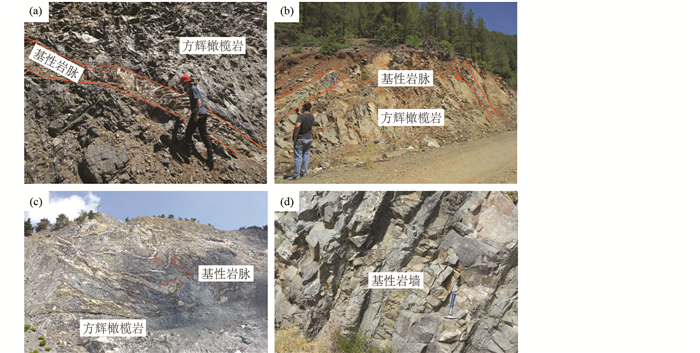
|
图 4 蛇绿岩中侵入的基性岩脉 (a、b) Pozantı-Karsantı蛇绿岩的方辉橄榄岩中侵入的基性岩脉;(c、d) Kızıldağ蛇绿岩中的基性岩脉和岩墙 Fig. 4 Mafic rocks in Pozantı-Karsantı (a, b) and Kızıldağ (c, d) ophiolites |
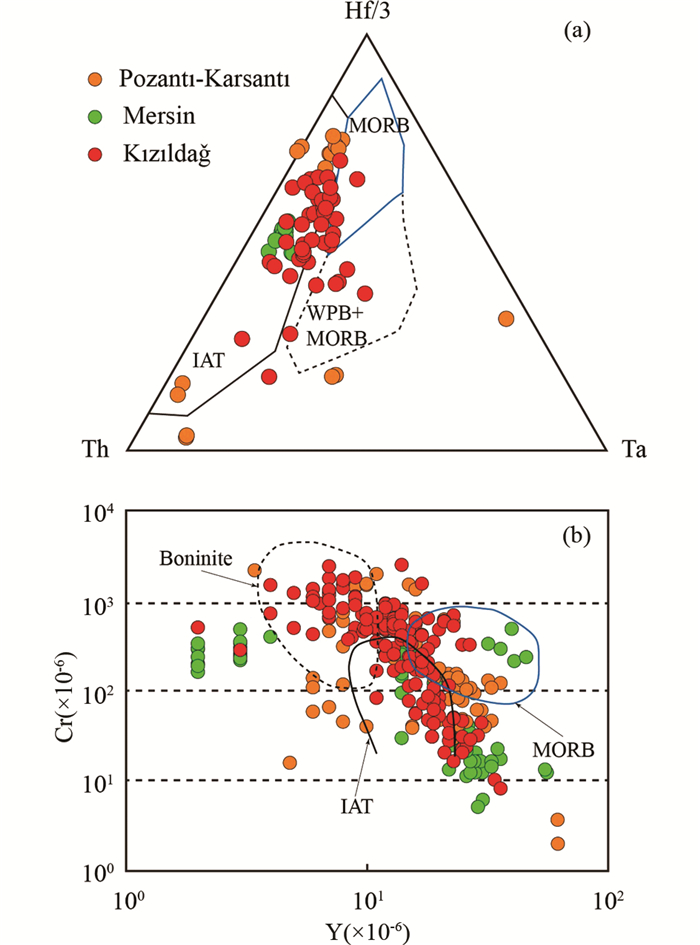
|
图 5 土耳其南部Kızıldağ、Mersin和Pozantı-Karsantı蛇绿岩中基性岩脉的全岩成分图解 数据引自Parlak et al., 1998, 2002; Parlak, 2000; Parlak and Robertson, 2004; Bağcı et al., 2008; Dilek and Thy, 2009; Rizeli et al., 2016; Lian et al., 2017; Sayit et al., 2017. IAT-岛弧拉斑玄武岩;MORB-洋中脊玄武岩;WPB-板内玄武岩;Boninite-玻安岩 Fig. 5 Plots of Ta-Th-Hf/3 (a) and Y vs. Cr (b) for mafic dykes from Kızı ldağ, Mersin and Pozantı-Karsantı ophiolites Data from Parlak et al., 1998, 2002; Parlak, 2000; Parlak and Robertson, 2004; Bağci et al., 2008; Dilek and Thy, 2009; Rizeli et al., 2016; Lian et al., 2017; Sayit et al., 2017. IAT: island-arc tholeiite; MORB: mid-ocean ridge basalt; WPB: within plate basalt |
土耳其南部蛇绿岩带广泛发育SSZ型和MORB-SSZ过渡型蛇绿岩,可能记录了大洋岩石圈的岩浆、构造演化过程,并提供古洋盆形成、发展和消亡等方面的重要信息(Parlak and Delaloye, 1996; Robertson, 2002; Dilek and Furnes, 2009; Chen et al., 2015; Lian et al., 2017)。在地中海地区,塞浦路斯Troodos蛇绿岩和阿曼Semail蛇绿岩是在初始俯冲阶段弧构造背景下形成的典型蛇绿岩(Stern, 2004; Reagan et al., 2010; Ishizuka et al., 2011; Whattam and Stern, 2011; Stern et al., 2012)。Kızıldağ蛇绿岩与Troodos和Semail蛇绿岩位于同一构造带内,且具有与Izu-Bonin-Mariana系统相似的特征,可能形成于俯冲早期阶段(Dilek and Thy, 2009; Chen et al., 2019)。另外,岩石和矿物的主微量及同位素研究表明,Pozantı-Karsantı蛇绿岩主要来源于亏损地幔,只有少量俯冲组分的加入,是在俯冲早期弧前构造背景下形成的(Lian et al., 2017; Su et al., 2018; 刘霞等, 2018)。Mersin蛇绿岩虽与Pozantı-Karsantı蛇绿岩处于同一构造带之内,构造环境却有所不同,被认为形成于弧后盆地拉张的构造环境(Sayit et al., 2017)。Antalya蛇绿岩经历的演化过程和构造背景则更为复杂,可能形成于弧前构造背景,后又经历了板片断裂或洋脊俯冲的改造(Bağcı and Parlak, 2009)。综上所述,土耳其南部蛇绿岩的构造背景和形成过程虽不尽相同,但均经历过俯冲改造,应为板块俯冲作用不同阶段的产物。
3.4 土耳其南部蛇绿岩带中的变质底板针对土耳其南部蛇绿岩带中广泛出露的变质底板,现有的研究和认识包括:1)含斜长角闪岩的变质底板总是作为蛇绿混杂岩和蛇绿岩之间的构造岩出现;2)角闪岩显示强烈的同变质构造(矿物片理与拉伸线理),与蛇绿岩的就位变形具有良好的一致性;3)与角闪岩互层的变沉积岩(大理岩、云母片岩或石英岩)显示出与角闪岩相一致的变形组构和变质级别;4)通过变质底板的结构(如矿物片理、相关的拉伸线理、与褶皱轴平行的矿物线理、不对称组构)及其与上覆蛇绿岩之间的构造关系研究,证实蛇绿岩中的变形作用与逆冲断层相关,而非走滑断层或拆离断层所致;5)有时可见变质底板和上覆蛇绿岩被一个与蛇绿岩无成因联系的岛弧拉斑质的基性岩横切,暗示了下伏于蛇绿混杂岩的基性岩被卷入俯冲带,裹挟至包含变质底板的上部板块,并且早于蛇绿岩就位进入游离的大洋岩石圈。因而该现象更能表明变质底板中角闪岩的变质作用最有可能发生在新特提斯洋俯冲带的初始俯冲过程;6)变质底板的年龄分布范围广,在64~110Ma时间段均有分布(图 6)(Dilek and Thy, 1992; Dilek and Whitney, 1997; Robertson, 2002; Karaoğlan et al., 2013b; Daşçı et al., 2015; Parlak, 2016; Lian et al., 2017)。除此之外,对变质底板的研究还揭示了部分岩石经历过高压变质作用的改造(Guilmette et al., 2009; Plunder et al., 2016),表明其后期可能经历过俯冲作用并沿俯冲通道构造折返(吴福元等, 2014)。同时,经历了高温变质作用的变质底板既可能与洋壳形成时的高温变质作用有关,也可能与后来的构造侵位过程相联系(Dewey and Casey, 2013)。
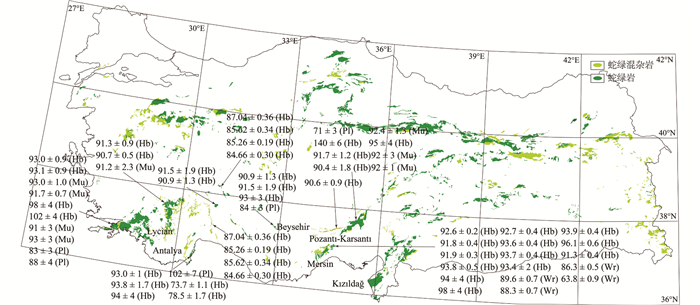
|
图 6 土耳其南部与蛇绿岩共生的变质底板分布与年龄(据土耳其矿物研究与勘探总局, 2002改编) 数据引自Thuizat et al., 1981; Dilek et al., 1999; Parlak and Delaloye, 1999; Robertson, 2002; Roepke et al., 2002; Önen, 2003; Çelik et al., 2006; Chan et al., 2007; Karaoğlan et al., 2013b; Daşçı et al., 2015; Parlak, 2016; Lian et al., 2017. Mu-白云母;Hb-角闪石;Pl-斜长石;Wr-全岩 Fig. 6 Distribution and ages of metamorphic soles associated with ophiolites in southern Turkey (modified after General Directorate of Mineral Research and Exploration, Turkey, 2002) Age data from Thuizat et al., 1981; Dilek et al., 1999; Parlak and Delaloye, 1999; Robertson, 2002; Roepke et al., 2002; Önen, 2003; Çelik et al., 2006; Chan et al., 2007; Karaoğlan et al., 2013b; Daşçı et al., 2015; Parlak, 2016; Lian et al., 2017. Mu-muscovite; Hb-hornblende; Pl-plagioclase; Wr-whole rock |
蛇绿岩与豆荚状铬铁矿间具有明显的成矿专属性,故铬铁矿床的形成过程与蛇绿岩的环境、所处的构造位置间存在密切联系。通常情况下,铬铁矿体赋存于蛇绿岩的两个层位中,地壳堆晶岩中或莫霍面以下的地幔橄榄岩中。前者通常形成似层状铬铁矿床,而后者大多形成了极具工业价值的豆荚状铬铁矿床。土耳其南部蛇绿岩均赋含不同规模的铬铁矿床:既有位于地幔方辉橄榄岩中的豆荚状铬铁矿,也有地壳堆晶岩中的(似)层状铬铁矿(Uysal et al., 2007, 2009; Saka et al., 2014; Chen et al., 2015, 2019; Avcı et al., 2017; 刘霞等, 2018),其中尤以豆荚状铬铁矿最为发育。整个南部蛇绿岩带上,豆荚状铬铁矿床主要为高Cr型,而Kızıldağ蛇绿岩中铬铁矿床则呈现出高Cr-高Al过渡型的特征(图 7)(Chen et al., 2015)。高Cr型铬铁矿主要被解释为玻安质岩浆与地幔橄榄岩的作用,而过渡型铬铁矿则是过渡型岩浆与地幔橄榄岩反应的结果(Uysal et al., 2007, 2009; Avcı et al., 2017; 刘霞等, 2018; Chen et al., 2019)。更为关键的是土耳其南部带内发育铬铁矿床的蛇绿岩,并非全都伴随有玻安岩的出露(Dilek et al., 1999)。这可能暗示了玻安质岩浆没有到达地壳深度,而是在上升过程中与地幔橄榄岩反应形成高Cr型铬铁矿床,亦或是高Cr型铬铁矿的形成与玻安岩之间并无必然联系。因此,土耳其南部蛇绿岩带内的铬铁矿床是蛇绿岩形成侵位、大洋俯冲起始和玻安质岩浆活动之间的关系纽带。
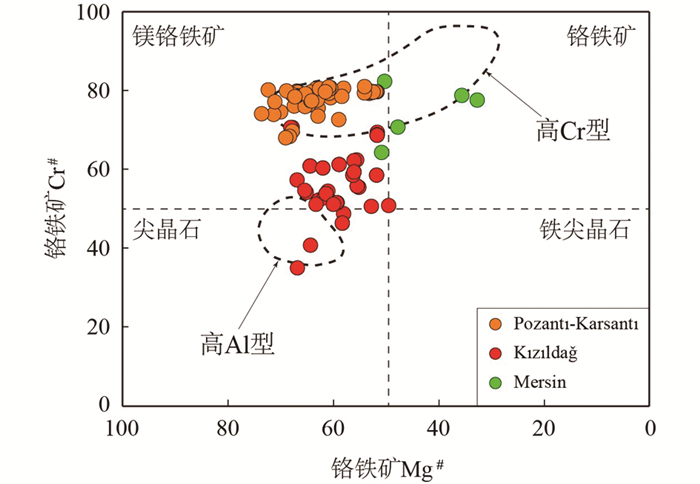
|
图 7 土耳其南部Kızıldağ、Mersin和Pozantı-Karsantı蛇绿岩中铬铁岩的铬铁矿的成分相关性图解 数据引自Parlak and Delaloye, 1996; Parlak et al., 2002; Bağcı et al., 2008; Chen et al., 2015; Rizeli et al., 2016; Avcı et al., 2017 Fig. 7 Plot of Mg# vs. Cr# for chromite in the chromitite from Kızıldağ, Mersin and Pozantı-Karsantı ophiolites Data from Parlak and Delaloye, 1996; Parlak et al., 2002; Bağcı et al., 2008; Chen et al., 2015; Rizeli et al., 2016; Avcı et al., 2017 |
初始俯冲是地球构造演化过程中的一个重要环节,尤其是在现行板块构造理论的框架下,其对地球科学的重要性不言而喻。同时,初始俯冲过程的研究对全球海陆构造演化以及地幔深部过程也有着重要的科学价值。蛇绿岩和变质底板是初始俯冲过程的重要印迹。从早期的三位一体同源结晶分异,到板块构造理论所主张的同源残留体-熔体成因假说,蛇绿岩的概念和内涵均经历了很大的变化。虽然蛇绿岩的产出遍布全球,但强烈的构造作用使得大部分地区并非蛇绿岩研究的理想落脚点。相反,土耳其南部蛇绿岩剖面连续完整,各类岩石蚀变轻微,并发育有与蛇绿岩密切伴生的变质底板,完整记录了新特提斯洋形成-俯冲-消减的演化过程。
致谢 野外工作得到了土耳其黑海技术大学İbrahim Uysal教授的大力支持;两位审稿人对本文进行了细致评阅并提出了宝贵的修改意见;在此一并表示感谢!
Allan JF and Dick HJB. 1996. Cr-rich spinel as a tracer for melt migration and melt-wall rock interaction in the mantle: Hess Deep, leg 147. In: Proceedings of the Ocean Drilling Program, Scientific Results, 147: 157-172
|
Al-Riyami K, Robertson A, Dixon J and Xenophontos C. 2002. Origin and emplacement of the Late Cretaceous Baër-Bassit ophiolite and its metamorphic sole in NW Syria. Lithos, 65(1-2): 225-260. DOI:10.1016/S0024-4937(02)00167-6 |
Arai S. 1992. Chemistry of chromian spinel in volcanic rocks as a potential guide to magma chemistry. Mineralogical Magazine, 56(383): 173-184. DOI:10.1180/minmag.1992.056.383.04 |
Arai S and Yurimato H. 1994. Podiform chromitites of the Tari-Misaka ultramafic complex, southwestern Japan, as mantle-melt interaction products. Economic Geology, 89(6): 1279-1288. DOI:10.2113/gsecongeo.89.6.1279 |
Arai S and Matsukage K. 1996. Petrology of the gabbro-troctolite-peridotite complex from Hess Deep, Equatorial Pacific: Implications for mantle-melt interaction within the oceanic lithosphere. In: Proceedings of the Ocean Drilling Program, Scientific Results, 147: 135-155
|
Arai S and Miura M. 2016. Formation and modification of chromitites in the mantle. Lithos, 264: 277-295. DOI:10.1016/j.lithos.2016.08.039 |
Avcı E, Uysal İ, Akmaz RM and Saka S. 2017. Ophiolitic chromitites from the Kızılyüksek area of the Pozantı-Karsantı ophiolite (Adana, southern Turkey):Implication for crystallization from a fractionated boninitic melt. Ore Geology Reviews, 90: 166-183. DOI:10.1016/j.oregeorev.2016.08.033 |
Baǧcı U, Parlak O and Höck V. 2008. Geochemistry and tectonic environment of diverse magma generations forming the crustal units of the Kızıldaǧ (Hatay) ophiolite, southern Turkey. Turkish Journal of Earth Sciences, 17: 43-71. |
Baǧcı U and Parlak O. 2009. Petrology of the Tekirova (Antalya) ophiolite (Southern Turkey):Evidence for diverse magma generations and their tectonic implications during Neotethyan-subduction. International Journal of Earth Sciences, 98(2): 387-405. DOI:10.1007/s00531-007-0242-7 |
Bao PS, Wang XB, Peng GY and Chen FY. 1999. Chromite Deposit in China. Beijing: Science Press: 99-142.
|
Beccaluva L, Coltorti M, Premti I, Saccani E, Siena F and Zeda O. 1994. Mid-ocean ridge and suprasubduction affinities in the ophiolitic belts of Albania. Ofioliti, 19(1): 77-96. |
Bortolotti V, Chiari M, Marroni M, Pandolfi L, Principi G and Saccani E. 2013. Geodynamic evolution of ophiolites from Albania and Greece (Dinaric-Hellenic belt):One, two, or more oceanic basins?. International Journal of Earth Sciences, 102(3): 783-811. DOI:10.1007/s00531-012-0835-7 |
Casey JF and Dewey JF. 1984. Initiation of subduction zones along transform and accreting plate boundaries, triple-junction evolution, and forearc spreading centres:Implications for ophiolitic geology and obduction. Geological Society, London, Special Publications, 13(1): 269-290. DOI:10.1144/GSL.SP.1984.013.01.22 |
Çelik ÖF, Delaloye M, Feraud G. 2006. Precise 40Ar-39Ar ages from the metamorphic sole rocks of the Tauride belt ophiolites, southern Turkey:Implications for the rapid cooling history. Geological Magazine, 143(2): 213-227. |
Çelik ÖF, Chiaradia M. 2008. Geochemical and petrological aspects of dike intrusions in the Lycian ophiolites (SW Turkey):A case study for the dike emplacement along the Tauride belt ophiolites. International Journal of Earth Sciences, 97(6): 1151-1164. |
Chan GHN, Malpas J, Xenophontos C and Lo CH. 2007. Timing of subduction zone metamorphism during the formation and emplacement of Troodos and Baër-Bassit ophiolites:Insights from 40Ar-39Ar geochronology. Geological Magazine, 144(5): 797-810. |
Chen C, Su BX, Uysal İ, Avcı E, Zhang PF, Xiao Y and He YS. 2015. Iron isotopic constraints on the origin of peridotite and chromitite in the Kızıldaǧ ophiolite, southern Turkey. Chemical Geology, 417: 115-124. DOI:10.1016/j.chemgeo.2015.10.001 |
Chen C, Su BX, Xiao Y, Pang KN, Robinson PT, Uysal İ, Lin W, Qin KZ, Avcı E and Kapsiotis A. 2019. Intermediate chromitite in Kızıldaǧ ophiolite (SE Turkey) formed during subduction initiation in Neo-Tethys. Ore Geology Reviews, 104: 88-100. DOI:10.1016/j.oregeorev.2018.10.004 |
Cloetingh SAPL, Wortel MJR and Vlaar NJ. 1982. Evolution of passive continental margins and initiation of subduction zones. Nature, 297(5862): 139-142. DOI:10.1038/297139a0 |
Coleman RG and Keith TE. 1971. A chemical study of serpentinization-Burro mountain, California. Journal of Petrology, 12(2): 311-328. DOI:10.1093/petrology/12.2.311 |
Coleman RG. 1977. Ophiolites:Ancient Oceanic Lithosphere?. Berlin Heidelberg: Springer-Verla: 1-229.
|
Crawford AJ, Falloon TJ and Green DH. 1989. Classification, petrogenesis and tectonic setting of boninites. In: Boninites. London: Unwin Hyman, 1-49
|
Daşçı HT, Parlak O, Nurlu N and Billor Z. 2015. Geochemical characteristics and age of metamorphic sole rocks within a Neotethyan ophiolitic mélange from Konya region (central southern Turkey). Geodinamica Acta, 27(4): 223-243. DOI:10.1080/09853111.2014.979532 |
Dewey JF. 1969. Continental margins:A model for conversion of Atlantic type to Andean type. Earth and Planetary Science Letters, 6(3): 189-197. DOI:10.1016/0012-821X(69)90089-2 |
Dewey JF and Bird JM. 1971. Origin and emplacement of the ophiolite suite:Appalachian ophiolites in Newfoundland. Journal of Geophysical Research, 76(14): 3179-3206. DOI:10.1029/JB076i014p03179 |
Dewey JF and Casey JF. 2013. The sole of an ophiolite:The Ordovician Bay of Island complex, Newfoundland. Journal of the Geological Society, 170(5): 715-722. DOI:10.1144/jgs2013-017 |
Dick HJB and Bullen T. 1984. Chromian spinel as a petrogenetic indicator in abyssal and Alpine-type peridotites and spatially associated lavas. Contributions to Mineralogy and Petrology, 86(1): 54-76. DOI:10.1007/BF00373711 |
Dick HJB and Natland JH. 1996. Late-stage melt evolution and transport in the shallow mantle beneath the East Pacific Rise. In: Proceedings of the Ocean Drilling Program, Scientific Results, 147: 103-134
|
Dickinson WR and Seely DR. 1979. Structure and stratigraphy of fore-arc regions. AAPG Bulletin, 63(1): 2-31. |
Dilek Y and Moores EM. 1990. Regional tectonics of the eastern Mediterranean ophiolites. In: Malpas J, Moores E, Panayiotou A and Xenophontos C (eds.). Ophiolites-oceanic Crustal Analogues. The Geological Survey Department, 295-305
|
Dilek Y and Thy P. 1992. Structure, petrology and geochronology of mafic dike intrusions in the Tauride belt (S. Turkey) and implications for the Neotethyan paleogeography. American Geophysical Union, 73: 546. |
Dilek Y and Whitney DL. 1997. Counterclockwise P-T-t trajectory from the metamorphic sole of a Neo-Tethyan ophiolite (Turkey). Tectonophysics, 280(3-4): 295-310. DOI:10.1016/S0040-1951(97)00038-3 |
Dilek Y, Thy P, Hacker B and Grundvig S. 1999. Structure and petrology of Tauride ophiolites and mafic dike intrusions (Turkey):Implications for the Neotethyan ocean. Geological Society of America Bulletin, 111(8): 1192-1216. DOI:10.1130/0016-7606(1999)111<1192:SAPOTO>2.3.CO;2 |
Dilek Y. 2003. Ophiolite concept and its evolution. Geological Society of America Special Paper, 373: 1-16. |
Dilek Y and Furnes H. 2009. Structure and geochemistry of Tethyan ophiolites and their petrogenesis in subduction rollback systems. Lithos, 113(1-2): 1-20. DOI:10.1016/j.lithos.2009.04.022 |
Dilek Y and Thy P. 2009. Island arc tholeiite to boninitic melt evolution of the Cretaceous Kızıldaǧ (Turkey) ophiolite:Model for multi-stage early arc-forearc magmatism in Tethyan subduction factories. Lithos, 113(1-2): 68-87. DOI:10.1016/j.lithos.2009.05.044 |
Dilek Y and Furnes H. 2011. Ophiolite genesis and global tectonics:Geochemical and tectonic fingerprinting of ancient oceanic lithosphere. Geological Society of America Bulletin, 123(3-4): 387-411. DOI:10.1130/B30446.1 |
Dilek Y and Furnes H. 2014. Ophiolites and their origins. Elements, 10(2): 93-100. DOI:10.2113/gselements.10.2.93 |
Dimo-Lahitte A, Monié P and Vergély P. 2001. Metamorphic soles from the Albanian ophiolites:Petrology, 40Ar/39Ar geochronology, and geodynamic evolution. Tectonics, 20(1): 78-96. DOI:10.1029/2000TC900024 |
Doin MP and Henry P. 2001. Subduction initiation and continental crust recycling:The roles of rheology and eclogitization. Tectonophysics, 342(1-2): 163-191. DOI:10.1016/S0040-1951(01)00161-5 |
Elitok Ö and Drüppel K. 2008. Geochemistry and tectonic significance of metamorphic sole rocks beneath the Beyşehir-Hoyran ophiolite (SW-Turkey). Lithos, 100(1-4): 322-353. DOI:10.1016/j.lithos.2007.06.022 |
Erickson SG. 1993. Sedimentary loading, lithospheric flexure, and subduction initiation at passive margins. Geology, 21(2): 125-128. DOI:10.1130/0091-7613(1993)021<0125:SLLFAS>2.3.CO;2 |
Fyfe WS and Leonardos OHJ. 1977. Speculations on the causes of crustal rifting and subduction, with applications to the Atlantic margin of Brazil. Tectonophysics, 42(1): 29-36. DOI:10.1016/0040-1951(77)90015-4 |
Gass IG. 1968. Is the Troodos Massif of cyprus a fragment of Mesozoic ocean floor?. Nature, 220(5162): 39-42. DOI:10.1038/220039a0 |
Gerya TV, Connally JAD and Yuen DA. 2008. Why is terrestrial subduction one-sided?. Geology, 36(1): 43-46. DOI:10.1130/G24060A.1 |
Girardeau J, Monnier C, Lemée L and Quatrevaux F. 2002. The Wuqbah peridotite, central Oman ophiolite:Petrological characteristics of the mantle in a fossil overlapping ridge setting. Marine Geophysical Researches, 23(1): 43-56. DOI:10.1023/A:1021297614067 |
Goren L, Aharonov E, Mulugeta G, Koyi HA and Mart Y. 2008. Ductile deformation of passive margins:A new mechanism for subduction initiation. Journal of Geophysical Research, 113(B8): B08411. |
Guilmette C, Hébert R, Dupuis C, Wang CS and Li ZJ. 2008. Metamorphic history and geodynamic significance of high-grade metabasites from the ophiolitic mélange beneath the Yarlung Zangbo ophiolites, Xigaze area, Tibet. Journal of Asian Earth Sciences, 32(5-6): 423-437. DOI:10.1016/j.jseaes.2007.11.013 |
Guilmette C, Hébert R, Wang CS and Villeneuve M. 2009. Geochemistry and geochronology of the metamorphic sole underlying the Xigaze ophiolite, Yarlung Zangbo Suture Zone, south Tibet. Lithos, 112(1-2): 149-162. DOI:10.1016/j.lithos.2009.05.027 |
Guilmette C, Hébert R, Dostal J, Indares A, Ullrich T, Bédard E and Wang CS. 2012. Discovery of a dismembered metamorphic sole in the Saga ophiolitic mélange, South Tibet:Assessing an Early Cretaceous disruption of the Neo-Tethyan supra-subduction zone and consequences on basin closing. Gondwana Research, 22(2): 398-414. DOI:10.1016/j.gr.2011.10.012 |
Gurnis M, Hall C and Lavier L. 2004. Evolving force balance during incipient subduction. Geochemistry, Geophysics, Geosystems, 5: Q07001. |
Hacker BR. 1990. Simulation of the metamorphic and deformational history of the metamorphic sole of the Oman ophiolite. Journal of Geophysical Research, 95(B4): 4895-4907. DOI:10.1029/JB095iB04p04895 |
Hall CE, Gurnis M, Sdrolias M, Lavier LL and Müller RD. 2003. Catastrophic initiation of subduction following forced convergence across fracture zones. Earth and Planetary Science Letters, 212(1-2): 15-30. DOI:10.1016/S0012-821X(03)00242-5 |
Hilde TWE, Uyeda S and Kroenke L. 1977. Evolution of the western Pacific and its margin. Tectonophysics, 38(1-2): 145-165. DOI:10.1016/0040-1951(77)90205-0 |
Ishizuka O, Tani K, Reagan MK, Kanayama K, Umino S, Harigane Y, Sakamoto I, Miyajima Y, Yuasa M and Dunkley DJ. 2011. The timescales of subduction initiation and subsequent evolution of an oceanic island arc. Earth and Planetary Science Letters, 306(3-4): 229-240. DOI:10.1016/j.epsl.2011.04.006 |
Juteau T, Megard F, Raharison L and Whitechurch H. 1977. Les assemblages ophiolitiques de l'occident equatorien; nature petrographique et position structurale. Bulletin de la Société Géologique de France, S7-XIX(5): 1127-1132. DOI:10.2113/gssgfbull.S7-XIX.5.1127 |
Juteau T. 1980. Ophiolites of Turkey. Ofioliti, 2: 199-237. |
Karaoǧlan F, Parlak O, Klötzli U, Thöni M and Koller F. 2012. U-Pb and Sm-Nd geochronology of the ophiolites from the SE Turkey:Implications for the Neotethyan evolution. Geodinamica Acta, 25(3-4): 146-161. DOI:10.1080/09853111.2013.858948 |
Karaoǧlan F, Parlak O, Klötzli U, Thöni M and Koller F. 2013a. U-Pb and Sm-Nd geochronology of the Kızıldaǧ (Hatay, Turkey) ophiolite:Implications for the timing and duration of suprasubduction zone type oceanic crust formation in the southern Neotethys. Geological Magazine, 150(2): 283-299. DOI:10.1017/S0016756812000477 |
Karaoǧlan F, Parlak O, Klötzli U, Koller F and Rızaoǧlu T. 2013b. Age and duration of intra-oceanic arc volcanism built on a suprasubduction zone type oceanic crust in southern Neotethys, SE Anatolia. Geoscience Frontiers, 4(4): 399-408. |
Karig DE. 1982. Initiation of subduction zones:Implications for arc evolution and ophiolite development. Geological Society, London, Special Publications, 10(1): 563-576. DOI:10.1144/GSL.SP.1982.010.01.37 |
Karson J and Dewey JF. 1978. Coastal complex, western Newfoundland:An Early Ordovician oceanic fracture zone. Geological Society of America Bulletin, 89(7): 1037-1049. DOI:10.1130/0016-7606(1978)89<1037:CCWNAE>2.0.CO;2 |
Kemp DV and Steveson DJ. 1996. A tensile, flexural model for the initiation of subduction. Geophysical Journal International, 125(1): 73-93. DOI:10.1111/gji.1996.125.issue-1 |
Lan CL, He SL and Li JL. 2006. Tectonic setting and metallogenic mechanism of ophiolitic chromites. Journal of Gansu Sciences, 18(1): 53-56. |
Lanphere MA, Coleman RG, Karamata S and Pamić J. 1975. Age of amphibolites associated with Alpine peridotites in the Dinaride ophiolite zone, Yugoslavia. Earth and Planetary Science Letters, 26(3): 271-276. DOI:10.1016/0012-821X(75)90001-1 |
Lian DY, Yang JS, Dilek Y, Liu F, Wu WW and Xiong FH. 2017. Geochemical, geochronological, and Sr-Nd isotopic constraints on the origin of the mafic dikes from the Pozantı-Karsantı ophiolite:Implications for tectonic evolution. The Journal of Geology, 125(2): 223-229. DOI:10.1086/690222 |
Liu X, Su BX, Bai Y, Chen C, Xiao Y, Liang Z, Yang SH, Peng QS, Su BC and Liu B. 2018. Ca-enrichment characteristics of parental magmas of chromitite in ophiolite:Inference from mineral inclusions. Earth Science, 43(4): 1038-1050. |
Lytwyn JN and Casey JF. 1995. The geochemistry of postkinematic mafic dike swarms and subophiolitic metabasites, Pozantı-Karsantı ophiolite, Turkey:Evidence for ridge subduction. Geological Society of America Bulletin, 107(7): 830-850. DOI:10.1130/0016-7606(1995)107<0830:TGOPMD>2.3.CO;2 |
Mart Y, Aharonov E, Mulugeta G, Ryan W, Tentler T and Goren L. 2005. Analogue modelling of the initiation of subduction. Geophysical Journal International, 160(3): 1081-1091. DOI:10.1111/gji.2005.160.issue-3 |
McKenzie DP. 1977. The initiation of trenches:A finite amplitude instability. American Geophysical Union: 57-61. |
Melcher F, Grum W, Simon G, Thalhammer TV and Stumpfl EF. 1997. Petrogenesis of the ophiolitic giant chromite deposits of Kempirsai, Kazakhstan:A study of solid and fluid inclusions in chromite. Journal of Petrology, 38(10): 1419-1458. DOI:10.1093/petroj/38.10.1419 |
Metcalf RV and Shervais JW. 2008. Suprasubduction-zone ophiolites:Is there really an ophiolite conundrum?. Geological Society of America Special Paper, 438: 191-222. |
Mitchell AHG. 1984. Initiation of subduction by post-collision foreland thrusting and back-thrusting. Journal of Geodynamics, 1(2): 103-120. DOI:10.1016/0264-3707(84)90023-1 |
Mueller S and Phillips RJ. 1991. On the initiation of subduction. Journal of Geophysical Research, 96(B1): 651-665. DOI:10.1029/90JB02237 |
Nikolaeva K, Gerya TV and Connolly JAD. 2008. Numerical modelling of crustal growth in intraoceanic volcanic arcs. Physics of the Earth and Planetary Interiors, 171(1-4): 336-356. DOI:10.1016/j.pepi.2008.06.026 |
Nikolaeva K, Gerya TV and Marques FO. 2010. Subduction initiation at passive margins:Numerical modeling. Journal of Geophysical Research, 115(B3): B03406. |
Niu YL, O'Hara MJ and Pearce JA. 2003. Initiation of subduction zones as a consequence of lateral compositional buoyancy contrast within the lithosphere:A petrological perspective. Journal of Petrology, 44(5): 851-866. DOI:10.1093/petrology/44.5.851 |
O'Neill C, Marchi S, Zhang S and Bottke W. 2017. Impact-driven subduction on the Hadean Earth. Nature Geoscience, 10(10): 793-797. DOI:10.1038/ngeo3029 |
Önen AP, Hall R. 2000. Sub-ophiolite metamorphic rocks from NW Anatolia, Turkey. Journal of Metamorphic Geology, 18(5): 483-495. |
Önen AP. 2003. Neotethyan ophiolitic rocks of the Anatolides of NW Turkey and comparison with Tauride ophiolites. Journal of the Geological Society, 160(6): 947-962. |
Parlak O, Delaloye M and Bingol E. 1995. Origin of sub-ophiolitic metamorphic rocks beneath the Mersin ophiolite, southern Turkey. Ofioliti, 20(2): 97-110. |
Parlak O and Delaloye M. 1996. Geochemistry and timing of post-metamorphic dyke emplacement in the Mersin ophiolite (southern Turkey):New age constraints from 40Ar/39Ar geochronology. Terra Nova, 8(6): 585-592. DOI:10.1111/ter.1996.8.issue-6 |
Parlak O, Kop A, Unlugenc UC and Demirkol C. 1998. Geochronology and geochemistry of basaltic rocks in the Karasu graben around Kirikhan (Hatay), S. Turkey. Turkish Journal of Earth Sciences, 7: 63-61. |
Parlak O and Delaloye M. 1999. Precise 40Ar/39Ar ages from the metamorphic sole of the Mersin ophiolite (southern Turkey). Tectonophysics, 301(1-2): 145-158. DOI:10.1016/S0040-1951(98)00222-4 |
Parlak O. 2000. Geochemistry and significance of mafic dyke swarms in the Pozantı-Karsantı ophiolite (southern Turkey). Turkish Journal of Earth Sciences, 9: 29-38. |
Parlak O, Höck V and Delaloye M. 2002. The supra-subduction zone Pozantı-Karsantı ophiolite, southern Turkey:Evidence for high-pressure crystal fractionation of ultramafic cumulates. Lithos, 65(1-2): 205-224. DOI:10.1016/S0024-4937(02)00166-4 |
Parlak O and Robertson A. 2004. The ophiolite-related Mersin Melange, southern Turkey:Its role in the tectonic-sedimentary setting of Tethys in the Eastern Mediterranean region. Geological Magazine, 141(3): 257-286. DOI:10.1017/S0016756804009094 |
Parlak O. 2006. Geodynamic significance of granitoid magmatism in the southeast Anatolian Orogen:Geochemical and geochronogical evidence from Göksun-Afşin (Kahramanmaraş, Turkey) Region. International Journal of Earth Sciences, 95(4): 609-627. DOI:10.1007/s00531-005-0058-2 |
Parlak O, Karaoǧlan F, Rizaoǧlu T, Klötzli U, Koller F and Billor Z. 2013. U-Pb and 40Ar-39Ar geochronology of the ophiolites and granitoids from the Tauride belt:Implications for the evolution of the Inner Tauride suture. Journal of Geodynamics, 65: 22-37. DOI:10.1016/j.jog.2012.06.012 |
Parlak O. 2016. The Tauride ophiolites of Anatolia (Turkey):A review. Journal of Earth Science, 27(6): 901-934. DOI:10.1007/s12583-016-0679-3 |
Pascal C and Cloetingh SAPL. 2009. Gravitational potential stresses and stress field of passive continental margins:Insights from the south-Norway shelf. Earth and Planetary Science Letters, 277(3-4): 464-473. DOI:10.1016/j.epsl.2008.11.014 |
Pearce JA, Lippard SJ and Roberts S. 1984. Characteristics and tectonic significance of supra-subduction zone ophiolites. Geological Society, London, Special Publications, 16(1): 77-94. DOI:10.1144/GSL.SP.1984.016.01.06 |
Pearce JA. 2003. Supra-subduction zone ophiolites:The search for modern analogues. Geological Society of America Special Paper, 373: 269-293. |
Pearce JA and Robinson PT. 2010. The Troodos ophiolitic complex probably formed in a subduction initiation, slab edge setting. Gondwana Research, 18(1): 60-81. DOI:10.1016/j.gr.2009.12.003 |
Pearce JA. 2014. Immobile element fingerprinting of ophiolites. Elements, 10(2): 101-108. DOI:10.2113/gselements.10.2.101 |
Peng H and Leng W. 2017. Progress in the study of subduction initiation. Journal of University of Science and Technology of China, 47(2): 163-175. |
Plunder A, Agard P, Chopin C, Soret M, Okay AI and Whitechurch H. 2016. Metamorphic sole formation, emplacement and blueschist facies overprint:Early subduction dynamics witnessed by western Turkey ophiolites. Terra Nova, 28(5): 329-339. DOI:10.1111/ter.2016.28.issue-5 |
Reagan MK, Ishizuka O, Stern RJ, Kelley KA, Ohara Y, Blichert-Toft J, Bloomer SH, Cash J, Fryer P, Hanan BB, Hickey-Vargas R, Ishii T, Kimura JI, Peate DW, Rowe MC and Woods M. 2010. Fore-arc basalts and subduction initiation in the Izu-Bonin-Mariana system. Geochemistry, Geophysics, Geosystems, 11: Q03X12. |
Regenauer-Lieb K, Yuen DA and Branlund J. 2001. The initiation of subduction:Criticality by addition of water?. Science, 294(5542): 578-580. DOI:10.1126/science.1063891 |
Rizeli ME, Beyarslan M, Wang KL and Bingöl AF. 2016. Mineral chemistry and petrology of mantle peridotites from the Guleman ophiolite (SE Anatolia, Turkey):Evidence of a forearc setting. Journal of African Earth Sciences, 123: 392-402. DOI:10.1016/j.jafrearsci.2016.08.013 |
Roberts SR. 1988. Ophiolitic chromitite formation:A marginal basin phenomenon?. Economic Geology, 83(5): 1034-1036. DOI:10.2113/gsecongeo.83.5.1034 |
Robertson AHF and Dixon JE. 1984. Introduction:Aspects of the geological evolution of the Eastern Mediterranean. Geological Society, London, Special Publications, 17(1): 1-74. DOI:10.1144/GSL.SP.1984.017.01.02 |
Robertson AHF. 2002. Overview of the genesis and emplacement of Mesozoic ophiolites in the eastern Mediterranean Tethyan region. Lithos, 65(1-2): 1-67. DOI:10.1016/S0024-4937(02)00160-3 |
Robinson PT, Trumbull RB, Schmitt A, Yang JS, Li JW, Zhou MF, Erzinger J, Dare S and Xiong FH. 2015. The origin and significance of crustal minerals in ophiolitic chromitites and peridotites. Gondwana Research, 27(2): 486-506. DOI:10.1016/j.gr.2014.06.003 |
Roepke J, Seidel E and Kreuzer H. 2002. Ophiolites on the southern Aegean islands Crete, Karpathos and Rhodes:Composition, geochronology and position within the ophiolite belts of the Eastern Mediterranean. Lithos, 65(1-2): 183-203. DOI:10.1016/S0024-4937(02)00165-2 |
Rollinson H. 2005. Chromite in the mantle section of the Oman ophiolite:A new genetic model. Island Arc, 14(4): 542-550. DOI:10.1111/iar.2005.14.issue-4 |
Saka S, Uysal I, Akmaz RM, Kaliwoda M and Hochleitner R. 2014. The effects of partial melting, melt-mantle interaction and fractionation on ophiolite generation:Constraints from the Late Cretaceous Pozantı-Karsantı ophiolite, southern Turkey. Lithos, 202-203: 300-316. DOI:10.1016/j.lithos.2014.05.027 |
Sayit K, Bedi Y, Tekin UK, Göncüoglu MC and Okuyucu C. 2017. Middle Triassic back-arc basalts from the blocks in the Mersin Mélange, southern Turkey:Implications for the geodynamic evolution of the northern Neotethys. Lithos, 268-271: 102-113. DOI:10.1016/j.lithos.2016.10.032 |
Searle MP and Malpas J. 1980. Structure and metamorphism of rocks beneath the Semail ophiolite of Oman and their significance in ophiolite obduction. Earth and Environmental Science Transactions of the Royal Society of Edinburgh, 71(4): 247-262. DOI:10.1017/S0263593300013614 |
Searle MP and Malpas J. 1982. Petrochemistry and origin of sub-ophiolitic metamorphic and related rocks in the Oman mountains. Journal of the Geological Society, 139(3): 235-248. DOI:10.1144/gsjgs.139.3.0235 |
Searle MP and Cox J. 1999. Tectonic setting, origin, and obduction of the Oman ophiolite. Geological Society of America Bulletin, 111(1): 104-122. DOI:10.1130/0016-7606(1999)111<0104:TSOAOO>2.3.CO;2 |
Şengör AMC, Yılmaz Y. 1981. Tethyan evolution of Turkey:A plate tectonic approach. Tectonophysics, 75(3-4): 181-241. |
Shi RD. 2005. Comment on the progress in and problems on ophiolite study. Geological Review, 51(6): 681-693. |
Solomatov VS. 2004. Correction to "Initiation of subduction by small-scale convection". Journal of Geophysical Research, 109(B5): B05408. |
Spray JG and Williams GD. 1980. The sub-ophiolite metamorphic rocks of the Ballantrae igneous complex, SW Scotland. Journal of the Geological Society, 137(3): 359-368. DOI:10.1144/gsjgs.137.3.0359 |
Spray JG. 1984. Possible causes and consequences of upper mantle decoupling and ophiolite displacement. In: Gass IG, Lippard SJ and Shelton AW (eds.). Ophiolites and Oceanic Lithosphere. Geological Society, London, Special Publications, 13(1): 255-268
|
Stern RJ and Bloomer SH. 1992. Subduction zone infancy:Examples from the Eocene Izu-Bonin-Mariana and Jurassic California arcs. Geological Society of America Bulletin, 104(12): 1621-1636. DOI:10.1130/0016-7606(1992)104<1621:SZIEFT>2.3.CO;2 |
Stern RJ. 2004. Subduction initiation:Spontaneous and induced. Earth and Planetary Science Letters, 226(3-4): 275-292. DOI:10.1016/S0012-821X(04)00498-4 |
Stern RJ, Reagan M, Ishizuka O, Ohara Y and Whattam S. 2012. To understand subduction initiation, study forearc crust:To understand forearc crust, study ophiolites. Lithosphere, 4(6): 469-483. DOI:10.1130/L183.1 |
Su BX, Chen C, Pang KN, Sakyi PA, Ibrahim U, Avci E, Liu X and Zhang PF. 2018. Melt penetration in oceanic lithosphere:Li isotope records from the Pozantı-Karsantı ophiolite in southern Turkey. Journal of Petrology, 59(1): 191-205. DOI:10.1093/petrology/egy023 |
Su BX, Xiao Y, Chen C, Bai Y, Liu X, Liang Z and Peng QS. 2018. Potential applications of Fe and Mg isotopes in genesis of chromite deposits in ophiolites. Earth Science, 43(4): 1011-1024. |
Thuizat R, Whitechurch H, Montigny R and Juteau T. 1981. K-Ar dating of some infra-ophiolitic metamorphic soles from the Eastern Mediterranean:New evidence for oceanic thrustings before obduction. Earth and Planetary Science Letters, 52(2): 302-310. DOI:10.1016/0012-821X(81)90185-0 |
Toth J and Gurnis M. 1998. Dynamics of subduction initiation at preexisting fault zones. Journal of Geophysical Research, 103(B8): 18053-18067. DOI:10.1029/98JB01076 |
Trumbull RB, Yang JS, Robinson PT, Di Pierro S, Vennemann T and Wiedenbeck M. 2009. The carbon isotope composition of natural SiC (moissanite) from the Earth's mantle:New discoveries from ophiolites. Lithos, 113(3-4): 612-620. DOI:10.1016/j.lithos.2009.06.033 |
Ueda K, Gerya T and Sobolev SV. 2008. Subduction initiation by thermal-chemical plumes:Numerical studies. Physics of the Earth and Planetary Interiors, 171(1-4): 296-312. DOI:10.1016/j.pepi.2008.06.032 |
Uyeda S and Ben-Avraham Z. 1972. Origin and development of the Philippine Sea. Nature Physical Science, 240(104): 176-178. DOI:10.1038/physci240176a0 |
Uysal İ, Zaccarini F, Garuti G, Meisel T, Tarkian M, Bernhardt HJ and Sadiklar MB. 2007. Ophiolitic chromitites from the Kahramanmaras area, southeastern Turkey:Their platinum-group elements (PGE) geochemistry, mineralogy and Os-isotope signature. Ofioliti, 32(2): 151-161. |
Uysal İ, Tarkian M, Sadiklar MB, Zaccarini F, Meisel T, Garuti G and Heidrich S. 2009. Petrology of Al-and Cr-rich ophiolitic chromitites from the Muǧla, SW Turkey:Implications from composition of chromite, solid inclusions of platinum-group mineral, silicate, and base-metal mineral, and Os-isotope geochemistry. Contributions to Mineralogy and Petrology, 158(5): 659-674. DOI:10.1007/s00410-009-0402-9 |
Uysal İ, Kapsiotis A, Akmaz RM, Saka S and Seitz HM. 2018. The Guleman ophiolitic chromitites (SE Turkey) and their link to a compositionally evolving mantle source during subduction initiation. Ore Geology Reviews, 93: 98-113. DOI:10.1016/j.oregeorev.2017.12.017 |
Van Der Lee S, Regenauer-Lieb K and Yuen DA. 2008. The role of water in connecting past and future episodes of subduction. Earth and Planetary Science Letters, 273(1-2): 15-27. DOI:10.1016/j.epsl.2008.04.041 |
van Hinsbergen DJJ, Peters K, Maffione M, Spakman W, Guilmette C, Thieulot C, Plümper O, Gürer D, Brouwer FM, Aldanmaz E and Kaymakcı N. 2015. Dynamics of intraoceanic subduction initiation:2. Suprasubduction zone ophiolite formation and metamorphic sole exhumation in context of absolute plate motions. Geochemistry, Geophysics, Geosystems, 16(6): 1771-1785. |
Vergely P, Dimo A and Monié P. 1998. Datation des semelles métamorphiques ophiolitiques d'Albanie par la méthode 40Ar/39Ar:Conséquences sur le mécanisme de leur mise en place 40Ar/39Ar dating of metamorphic soles from the Albanian ophiolites:Implications for their emplacement models. Comptes Rendus de l'Académie des Sciences-SeriesⅡA-Earth and Planetary Science, 326(10): 717-722. |
Wakabayashi J and Dilek Y. 2000. Spatial and temporal relations between ophiolites and their subophiolitic soles:A test of models of forearc ophiolite genesis. Geological Society of America Special Paper, 349: 53-64. |
Wakabayashi J and Dilek Y. 2003. What constitutes "emplacement" of an ophiolite:Mechanisms and relationship to subduction initiation and formation of metamorphic soles. Geological Society, London, Special Publications, 218(1): 427-447. DOI:10.1144/GSL.SP.2003.218.01.22 |
Whattam SA and Stern RJ. 2011. The "subduction initiation rule":A key for linking ophiolites, intra-oceanic forearcs, and subduction initiation. Contributions to Mineralogy and Petrology, 162(5): 1031-1045. DOI:10.1007/s00410-011-0638-z |
Wu FY, Liu CZ, Zhang LL, Zhang C, Wang JG, Ji WQ and Liu XC. 2014. Yarlung Zangbo ophiolite:A critical updated view. Acta Petrologica Sinica, 30(2): 293-325. |
Xiao QH, Li TD, Pan GT, Lu SN, Ding XZ, Deng JF, Feng YM, Liu Y, Kou CH and Yang LL. 2016. Petrologic ideas for identification of ocean-continent transition:Recognition of intra-oceanic arc and initial subduction. Geology in China, 43: 721-737. |
Xiao Y, Teng FZ, Su BX, Hu Y, Zhou MF, Zhu B, Shi RD, Huang QS, Gong XH and He YS. 2016. Iron and magnesium isotopic constraints on the origin of chemical heterogeneity in podiform chromitite from the Luobusa ophiolite, Tibet. Geochemistry, Geophysics, Geosystems, 17(3): 940-953. DOI:10.1002/2015GC006223 |
Xiong FH, Yang JS, Ba DZ, Liu Z, Xu XZ, Feng GY, Niu XL and Xu JF. 2014. Different type of chromitite and genetic model from Luobusa ophiolite, Tibet. Acta Petrologica Sinica, 30(8): 2137-2163. |
Xu XZ, Yang JS, Robinson PT, Xiong FH, Ba DZ and Guo GL. 2015. Origin of ultrahigh pressure and highly reduced minerals in podiform chromitites and associated mantle peridotites of the Luobusa ophiolite, Tibet. Gondwana Research, 27(2): 686-700. DOI:10.1016/j.gr.2014.05.010 |
Yamamoto S, Komiya T, Hirose K and Maruyama S. 2009. Coesite and clinopyroxene exsolution lamellae in chromites:In-situ ultrahigh-pressure evidence from podiform chromitites in the Luobusa ophiolite, southern Tibet. Lithos, 109(3-4): 314-322. DOI:10.1016/j.lithos.2008.05.003 |
Yang JS, Dobrzhinetskaya L, Bai WJ, Fang QS, Robinson PT, Zhang JF and Green HW. 2007. Diamond-and coesite-bearing chromitites from the Luobusa ophiolite, Tibet. Geology, 35(10): 875-878. DOI:10.1130/G23766A.1 |
Yang JS, Bai WJ, Fang QS, Meng FC, Chen SY, Zhang ZM and Rong H. 2007. Discovery of diamond and an unusual mineral group from the podiform chromite, Polar Ural. Geology in China, 34(5): 950-952. |
Yang JS, Bai WJ, Fang QS and Rong H. 2008. Ultrahigh-pressure minerals and new minerals from the Luobusa ophiolitic chromitites in Tibet:A review. Acta Geoscientica Sinica, 29(3): 263-274. |
Yang JS, Robinson PT and Dilek Y. 2014. Diamonds in ophiolites. Elements, 10(2): 127-130. DOI:10.2113/gselements.10.2.127 |
Zhang PF, Uysal I, Zhou MF, Su BX and Avci E. 2016. Subduction initiation for the formation of high-Cr chromitites in the Kop ophiolite, NE Turkey. Lithos, 260: 345-355. DOI:10.1016/j.lithos.2016.05.025 |
Zhang QZ, Ba DZ, Xiong FH and Yang JS. 2017. Discussion on genesis process and deep prospecting breakthrough of Luobusa chromitite, Tibet. Geology in China, 44(2): 224-241. |
Zhou MF, Robinson PT and Bai WJ. 1994. Formation of podiform chromitites by melt/rock interaction in the upper mantle. Mineralium Deposita, 29(1): 98-101. DOI:10.1007/BF03326400 |
Zhou MF, Robinson PT, Malpas J and Li ZJ. 1996. Podiform chromitites in the Luobusa ophiolite (southern Tibet):Implications for melt-rock interaction and chromite segregation in the upper mantle. Journal of Petrology, 37(1): 3-21. DOI:10.1093/petrology/37.1.3 |
Zhou MF, Sun M, Keays RR and Kerrich RW. 1998. Controls on platinum-group elemental distributions of podiform chromitites:A case study of high-Cr and high-Al chromitites from Chinese orogenic belts. Geochimica et Cosmochimica Acta, 62(4): 677-688. DOI:10.1016/S0016-7037(97)00382-7 |
Zhou MF, Robinson PT, Malpas J, Edwards SJ and Qi L. 2005. REE and PGE geochemical constraints on the formation of dunites in the Luobusa ophiolite, southern Tibet. Journal of Petrology, 46(3): 615-639. |
Zhou MF, Robinson PT, Su BX, Gao JF, Li JW, Yang JS and Malpas J. 2014. Compositions of chromite, associated minerals, and parental magmas of podiform chromite deposits:The role of slab contamination of asthenospheric melts in suprasubduction zone environments. Gondwana Research, 26(1): 262-283. DOI:10.1016/j.gr.2013.12.011 |
Zhu GZ, Gerya TV, Yuen DA, Honda S, Yoshida T and Connolly JAD. 2009. Three-dimensional dynamics of hydrous thermal-chemical plumes in oceanic subduction zones. Geochemistry, Geophysics, Geosystems, 10: Q11006. |
鲍佩声, 王希斌, 彭根永, 陈方远. 1999. 中国铬铁矿床. 北京: 科学出版社: 99-142.
|
兰朝利, 何顺利, 李继亮. 2006. 蛇绿岩铬铁矿形成环境和成矿机制. 甘肃科学学报, 18(1): 53-56. DOI:10.3969/j.issn.1004-0366.2006.01.013 |
刘霞, 苏本勋, 白洋, 陈晨, 肖燕, 梁子, 杨赛红, 彭青山, 苏本灿, 刘斌. 2018. 蛇绿岩中铬铁岩母岩浆的富Ca特征:矿物包裹体证据. 地球科学, 43(4): 1038-1050. |
彭鸿, 冷伟. 2017. 俯冲板块初始化过程的研究进展. 中国科学技术大学学报, 47(2): 163-175. DOI:10.3969/j.issn.0253-2778.2017.02.007 |
史仁灯. 2005. 蛇绿岩研究进展、存在问题及思考. 地质评论, 51(6): 681-693. |
苏本勋, 肖燕, 陈晨, 白洋, 刘霞, 梁子, 彭青山. 2018. Fe-Mg同位素在蛇绿岩中铬铁矿床成因研究中的应用潜力. 地球科学, 43(4): 1011-1024. |
吴福元, 刘传周, 张亮亮, 张畅, 王建刚, 纪伟强, 刘小驰. 2014. 雅鲁藏布蛇绿岩——事实与臆想. 岩石学报, 30(2): 293-325. |
肖庆辉, 李廷栋, 潘桂棠, 陆松年, 丁孝忠, 邓晋福, 冯益民, 刘勇, 寇彩化, 杨琳琳. 2016. 识别洋陆转换的岩石学思路——洋内弧与初始俯冲的识别. 中国地质, 43(3): 721-737. |
熊发挥, 杨经绥, 巴登珠, 刘钊, 徐向珍, 冯光英, 牛晓露, 徐继峰. 2014. 西藏罗布莎不同类型铬铁矿的特征及成因模式讨论. 岩石学报, 30(8): 2137-2163. |
杨经绥, 白文吉, 方青松, 孟繁聪, 陈松永, 张仲明, 戎合. 2007. 极地乌拉尔豆荚状铬铁矿中发现金刚石和一个异常矿物群. 中国地质, 34(5): 950-952. DOI:10.3969/j.issn.1000-3657.2007.05.024 |
杨经绥, 白文吉, 方青松, 戎合. 2008. 西藏罗布莎蛇绿岩铬铁矿中的超高压矿物和新矿物(综述). 地球学报, 29(3): 263-274. DOI:10.3321/j.issn:1006-3021.2008.03.002 |
章奇志, 巴登珠, 熊发挥, 杨经绥. 2017. 西藏罗布莎豆荚状铬铁矿床深部找矿突破与成因模式讨论. 中国地质, 44(2): 224-241. |
 2018, Vol. 34
2018, Vol. 34


